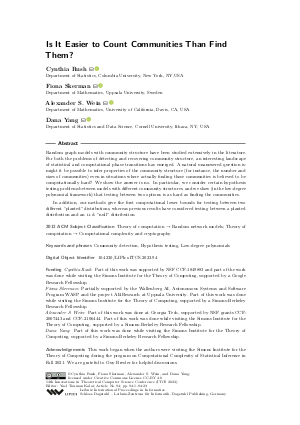@InProceedings{rush_et_al:LIPIcs.ITCS.2023.94,
author = {Rush, Cynthia and Skerman, Fiona and Wein, Alexander S. and Yang, Dana},
title = {{Is It Easier to Count Communities Than Find Them?}},
booktitle = {14th Innovations in Theoretical Computer Science Conference (ITCS 2023)},
pages = {94:1--94:23},
series = {Leibniz International Proceedings in Informatics (LIPIcs)},
ISBN = {978-3-95977-263-1},
ISSN = {1868-8969},
year = {2023},
volume = {251},
editor = {Tauman Kalai, Yael},
publisher = {Schloss Dagstuhl -- Leibniz-Zentrum f{\"u}r Informatik},
address = {Dagstuhl, Germany},
URL = {https://drops.dagstuhl.de/entities/document/10.4230/LIPIcs.ITCS.2023.94},
URN = {urn:nbn:de:0030-drops-175970},
doi = {10.4230/LIPIcs.ITCS.2023.94},
annote = {Keywords: Community detection, Hypothesis testing, Low-degree polynomials}
}

 Creative Commons Attribution 4.0 International license
Creative Commons Attribution 4.0 International license

















